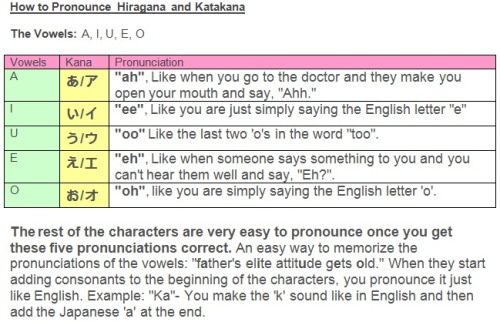#lesson

You can’t cling to the past because no matter how tightly you hold on … it’s already gone
:’)
Sun, 24 Apr 2022 13:20:13
Wed, 31 Oct 2012 00:10:28
Mon, 17 Sep 2012 15:52:14
Sun, 16 Sep 2012 18:52:37
Learning Japanese: (1) Alphabet and Pronunciation
Part 1A: Kana sounds
Japanese pronunciation notes:
- Consonants are pronounced like the English letter sound, except for ‘R’ which is pronounced between an 'L’ and an 'R’.
- Double vowels (aa, ii, uu, ee, oo) are pronounced twice as long as the single vowel.
- Don’t say the characters in your head, say them out loud so you can get more speaking practice.
- Memorize the Kana symbols with vivid pictures. For instance; き “ki” looks and sounds similar to “key”.
- If you’re going to Japan, take some time out to learn about their body/hand gestures too! Actions speak louder than words and some body/hand gestures that are okay in your country may not be okay or polite in Japan. If you do something that does offend someone, just apologize to them.
HIRAGANA NOTES:
- The hiragana syllabary is used to write word endings and Japanese words, replacing the kanji if the kanji is not widely known or the readers are children. It can also be used alongside kanji to indicate its pronunciation.
- When there is a “little tsu”(つ) inside a word (ie. きった), it means that the consonant of the next syllable is doubled. For instance, きった is kitta (“keet-tah”) and means “cut” as in “cut the cake”, whereas きた is kita (“keetah”) and means “north”.
- The vowels i and u are often silent or barely pronounced in most Japanese words, especially when they are located at the end of certain verbs. It is also the case of the vowel “u” that follows the consonant “s”. For example, “arimasu” (there is) is pronounced “ah-ree-mas”, “deshita” (was) is pronounced “deh-shtah”, and “suki” (to like) is pronounced “skee”.
- Romanized Japanese words with ō translate as ou, or おう
- When は,をandへ are used as sentence particles, they are respectively pronounced wa (“wah”), o (“oh”) and e (“eh”)…particle lessons later (stay focused on your current task)
KATAKANA NOTES:
- The katakana syllabary is used to write a word borrowed from a foreign language, as well as all foreign names and onomatopoeia. It can also be use for emphasis, similar to using bold or italic text in English.
- In katakana, the character (ー) is used to double the vowel of the preceding character. For instance, the word “game” uses katakana characters for being a foreign word, and is written “ゲーム" : "geehmu” (the final u is barely pronounced).
Post link
Last night’s #basics #class @ ritmo studio’s #Hasselt .
#janet #jackson #all4u #janetjackson #streetjazz #hiphop #basic #lesson #dance #choreography #choreo #raiders #puma #suede






